Excerpts from Jim Conrad's
Naturalist Newsletter





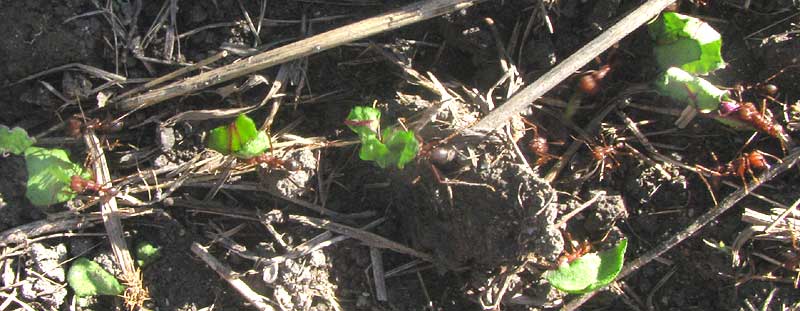
from the November 11, 2012 Newsletter issued from the valley of the Dry Frio River in northern Uvalde County, southwestern Texas, on the southern border of the Edwards Plateau; elevation ~1750m (~5750 ft); N29.62°, W99.86°; USA
LEAFCUTTER ANTS IN TEXAS
One of my biggest surprises when I arrived here in southwestern Texas is that leafcutter ants occur here. Already during my first week of gardening here I became acquainted with our Texas leafcutters because each night they formed a busy column passing through the center of my fenced-in, raised-bed garden area, to get to the big Chinaberry tree at the corner, which they were methodically defoliating. They didn't bother my raised beds, however, so I let them be -- until the day I found scouts wandering through my bed of mustard greens looking very interested.
Then I did what the Maya taught me to do: I sprayed a very light but smelly application of diesel fuel around the bases of the beds. The scouts immediately disappeared and the line through the garden, which previously had run alongside a couple of beds, was changed to run between them. This peaceful but unsteady state of coexistence was maintained until one morning this week when in my other, on-the-ground garden I found what's shown below:
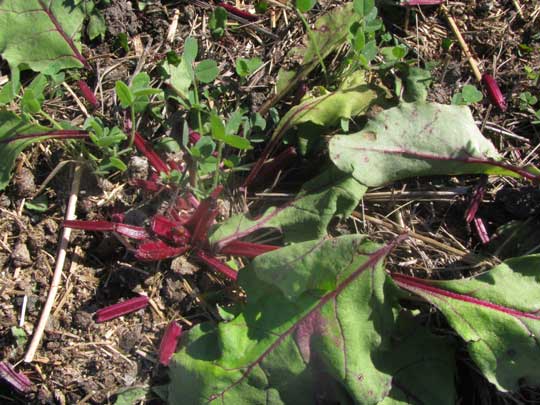
Those are beet leaves cut from their dark purple stems as neatly as if snipped off with scissors. My entire beet planting was like that, with wilting leaves lying on the ground. Leading away from my beet bed was a line of large, orangish ants, most of them carrying cut-out tatters of beet leaves, as shown at the top of this page.
A close-up of a single ant carrying its beet-leaf umbrella is below:
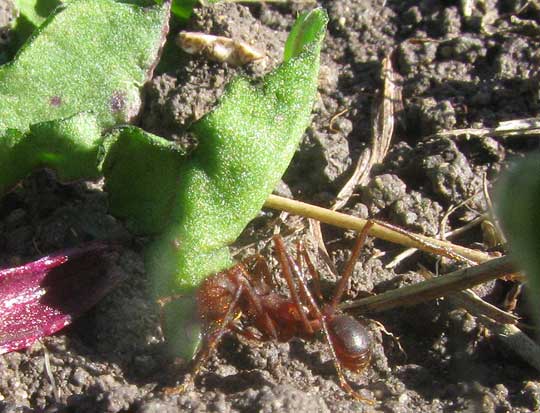
I sprayed a light application of diesel along the side of the garden between my plants and the ants' nest, and so far they have not returned.
Apparently there's only one leafcutter ant species in Texas, and that's the Texas Leafcutting Ant, ATTA TEXANA, distributed in southern and eastern Texas, western Louisiana, and in Mexico in the arid northeastern states and along the Gulf of Mexico as far south as Tabasco state. You may like to see the GBIF Occurrence Map for the Texas Leafcutter.
from the December 23, 2012 Newsletter issued from the valley of the Dry Frio River in northern Uvalde County, southwestern Texas, on the southern border of the Edwards Plateau; elevation ~1750m (~5750 ft); N29.62°, W99.86°; USA
LEAFCUTTER ANTS IN THE COMPOST
Since writing the above I've gained much unwanted experience with these ants. They cut the tops off many of my Japanese Radishes before I discovered them and sprayed diesel fuel around the raised bed -- a trick I learned from the Maya in the Yucatan. Later they got every leaf of my Tat Soi. They choose one target kind of plant and go after it, ignoring other crops you'd think they might prefer.
I can halfway deal with them by spraying around the raised beds. However, now that they're attacking the big garden it's harder. At first I sprayed all around the big garden, something I disliked very much because this diesel fuel is disgusting stuff. However, I've been planning on eating from that garden and if the ants take it all it's a hard blow.
One day somehow they found a way across my diesel barrier and overnight dug tunnels inside the garden, right beside my turnip patch, and began ravaging the turnips. I dug up their nest and thought I had them controlled, but then the next morning new tunnels appeared in the center of the turnip patch. I sprayed a little but finally realized that I was creating more mess with that diesel fuel than it was worth, so now I just let the ants have what they want. As I write this they are gradually destroying my house-size patch of turnips.
One day this week I was saddened to see a line of leaf-carrying ants in my spinach bed, for I'd hoped they might ignore that crop. However, as I searched for where they were working I found that the line passed through the spinach and beyond, across the entire garden, through the fence and out of the garden, into the compost bin. They were dissecting the rinds of winter squash recently deposited there. You can see some at work on a rind below:
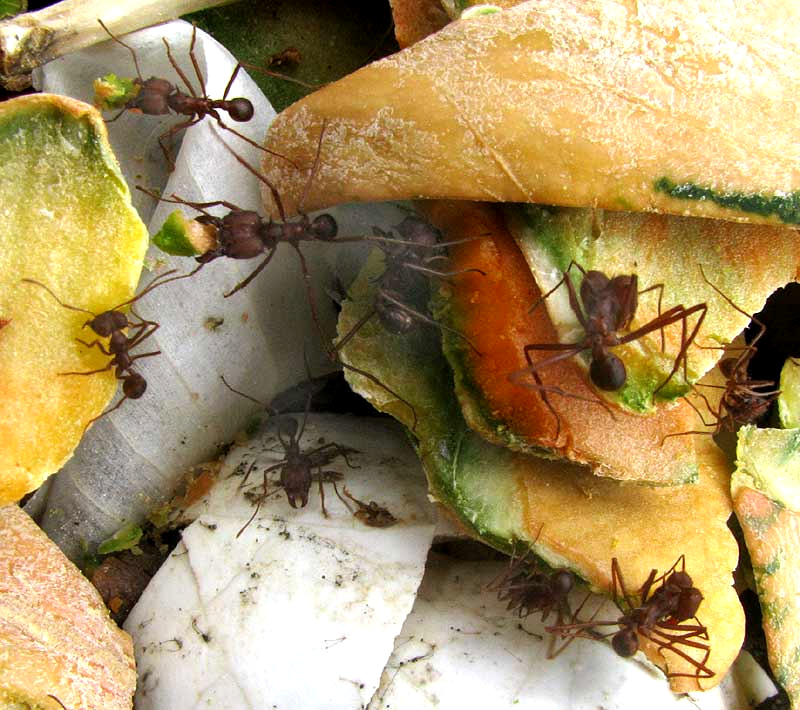
It would be easy to kill off the colony with ant poison, but I have my own reasons for not doing that.
from the June 1, 2014 Newsletter issued from the Frio Canyon Nature Education Center in the valley of the Dry Frio River in northern Uvalde County, southwestern Texas, on the southern border of the Edwards Plateau; elevation ~1750m (~5750 ft); N29.62°, W99.86°; USA
EMERGENCE OF BIG-BOTTOMED ANTS
Early Tuesday morning after the big rain on Memorial Day Monday thousands of very large, amber-colored flying ants turned up dead and dying on the community's gravel road, below a streetlight kept on all night. Below, you can see one picked up as it staggered across the gravel:
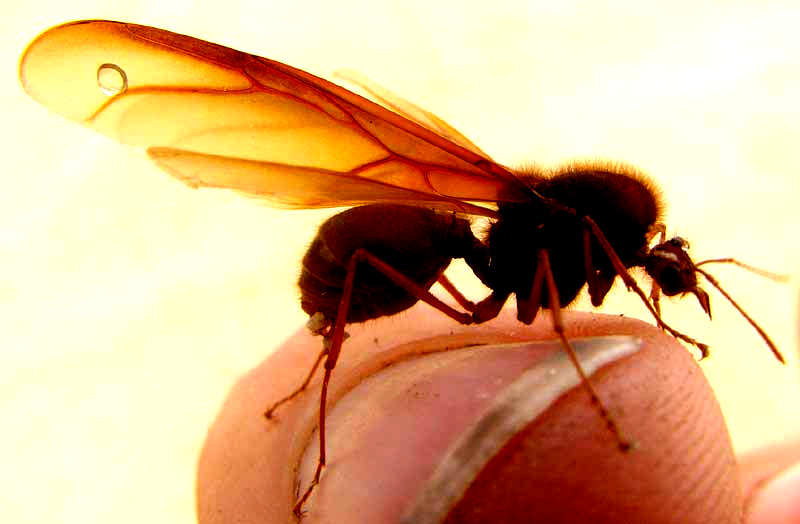
A view of a dead one from below is shown below:
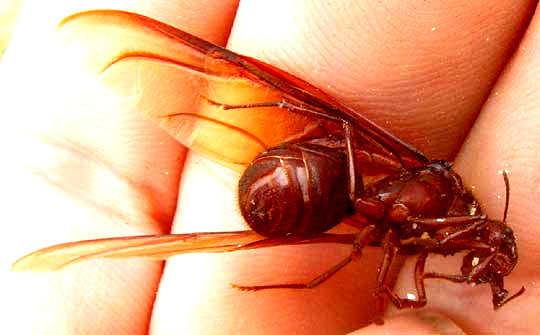
In 2007 in the central Mexican state of Querétaro we saw the same thing, similarly occurring on the day after the first big rain of what normally is the rainy season. You might enjoy reviewing the page describing that outbreak, and brings up the matter than in some places the arrival of these big ants is highly anticipated because they are eaten with relish, and are thought to have aphrodisiacal properties.
In Querétaro we learned that the big, flying ants were male leafcutting ants. The species seen there were Atta mexicana. These winged males, called drones or "male alates," are very much larger than the wingless, sterile workers normally seen carrying cut-out shreds of leaves as they march in long lines between their vast underground nests and whatever plant they happen to be defoliating. Last summer they destroyed my beet and turnip crops.
Once a leafcutting ant colony grows to a certain stage, newly hatched queens fly off followed by clouds of males. Once the time for sex has passed, whether the males had luck with the queen or not, the males die. The story of all those dead ants on the community's road, then, was that on Memorial Day night, at least one queen had left a leafcutter nest followed by many males, and now the males were dead or dying, probably drawn there by the streetlight.
As I surveyed the males' dying field, a wingless ant even larger than they emerged from grass along the road, its head and scissor-like mandibles proportionately much larger than those of the males'. It's shown below:
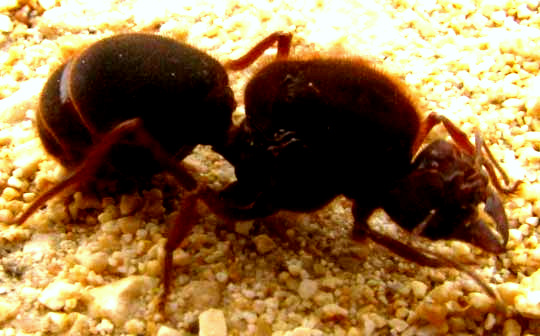
Though structurally it was similar to the male leafcutters, my first thought was that it was some kind of gigantic carnivorous ant about to feed on the dead and dying male leafcutters on the road. Below, you can see how large this big, wingless ant was on my hand:
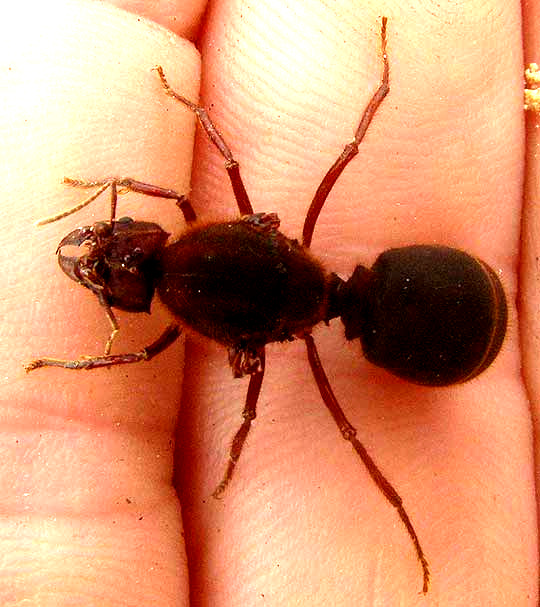
In that shot you can clearly see wing stumps, so apparently that ant also recently had flown into the area. A close-up of this big one's head is shown below:
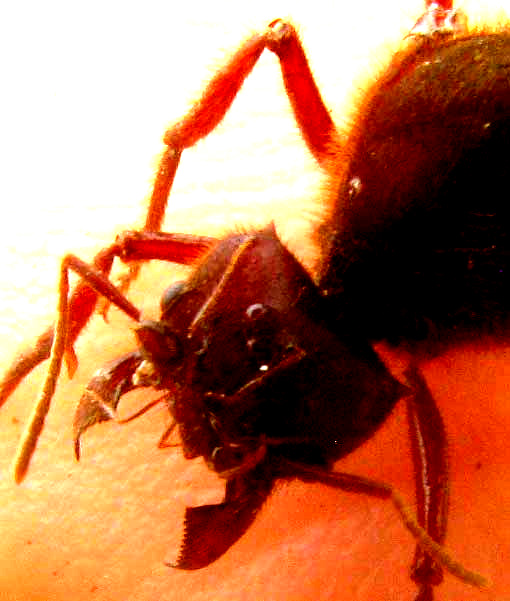
I watched as a second big, wingless ant entered the dying field headed toward a male who seemed more alive than most of the rest. I thought I might see a fight, but instead I saw what's shown below:
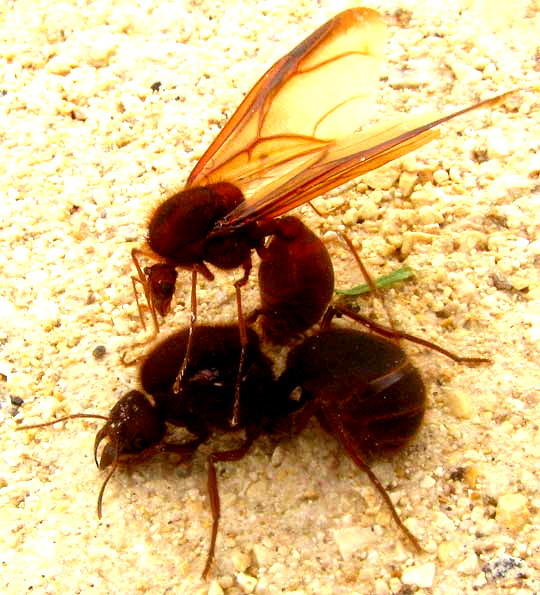
Several times the male climbed atop the big, black ant and made half-hearted gestures suggesting the sexual act. Though the big ant appeared to be receptive to the idea, no sex took place, if only because all the drones in this dying field were too weak or exhausted to perform.
Apparently the big, black, wingless ant was a queen. Numerous wings were lying loose on the road, so maybe there were more queens than the two I saw, and they'd landed there after mating in the air, lost their wings, and now were off somewhere digging their own nests.
The next morning all hints of this drama were missing from the road.